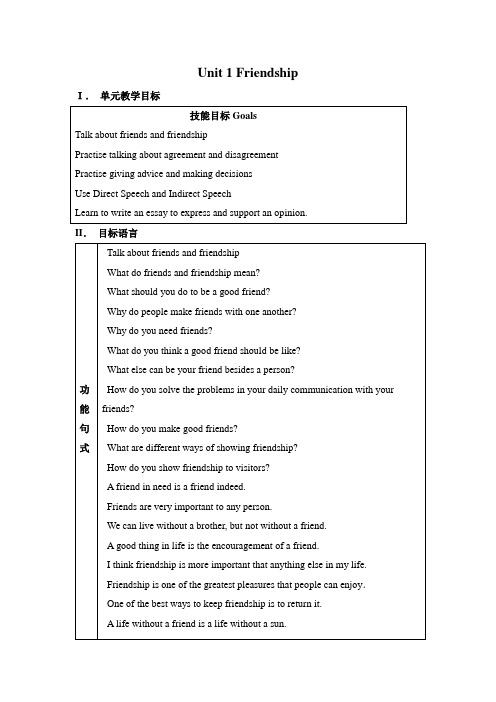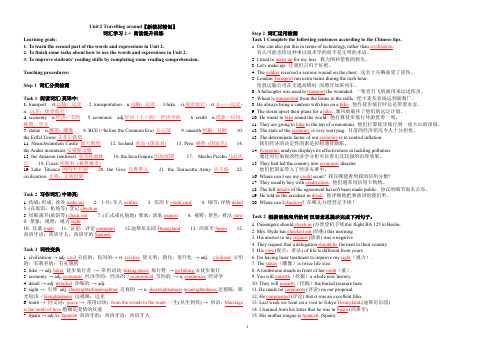高一人教版英语教案
- 格式:docx
- 大小:18.72 KB
- 文档页数:15

Unit 1 Friendship I.单元教学目标II.目标语言III. 教材分析和教材重组1. 教材分析本单元以Friend和Friendship为话题,旨在通过单元教学使学生通过讨论什么是好朋友,什么是真正的友谊,如何交友和保持友谊等问题,使学生树立正确的交友观。
并针对日常交友过程中经常遇到的实际问题,指导学生发表自己的见解和看法,通过进一步讨论提供有效的解决方案。
并能就此以编辑的身份写出指导信,对相关谚语写出观点明确、论证有力的短文。
1.1 Warming Up以调查问卷的形式,通过对学生在日常交友过程中所遇到的五个问题,展开调查,使学生对是否擅长交友做出评价,激发学生对本单元的中心话题产生兴趣;同时也使教师本单元的授课更具有针对性,从而有效地帮助学生树立正确的交友观。
1.2 Pre-Reading通过四个问题引导学生讨论交友的重要性以及自己心目中好朋友的概念和标准,并使学生认识到不仅人与人,人与物(如日记)也可以成为好朋友。
继续探究并树立正确交友观,并为阅读作好了准备。
1.3 Reading讲述第二次世界大战的纳粹统治时期,犹太人Anne一家过着滇沛流漓,与世隔绝的生活。
Anne在孤独中只能以日记Kitty 为友,倾诉衷肠,伴其渡过两年的逃亡生涯。
控诉了纳粹党的残暴统治给犹太人民带来了深重的灾难,并以日记的形式表达了以主人公Anne为代表的全世界人民憎恨战争渴望和平的共同心愿。
学生学习了新的词汇、句型,提高了阅读水平。
文中选用了主人公的一篇日记,使学生进一步感受到了挚友的可贵,对主人公内心世界的描写有了更深刻的理解。
1.4 Comprehension 设计了三种题型。
其中前两个是考查学生对READING文章细节内容的理解,最后一题是开放性问题,学生可以在更深入理解主人公内心世界的基础上各抒己见,使学生养成勤于思考勇于探究的良好的学习习惯,现时也培养了学生的想象力,进一步提高了阅读水平。

Unit 2 Travelling AroundListening and Speaking 教学设计科目:英语课题:Listening and Speaking 课时:1 课时教学目标与核心素养:知识目标:熟悉表达将来计划的语言结构,为本单元的语法学习做好铺垫。
能力目标:培养学生制定计划时全面考虑、系统安排的意识和能力。
情感目标:增强学生的爱国情怀,开阔学生的国际视野。
教学重难点:教学重点:帮助学生掌握通过听关键词获取关键信息的技能教学难点:了解现在进行时表示将来计划的语言结构,掌握关于行前准备的常用表达。
课前准备:多媒体,黑板,粉笔教学过程:一、Pre-listening1. Greeting2. Leading-in教师活动:Show some pictures of travelling.学生活动:学生讨论活动1 中的问题。
二、While- listening学生活动:(1)学生浏览活动2 中的问题和选项,预测听力内容。
学生听第一段对话,完成选择,然后师生核对答案。
(2)学生浏览活动3 的听力任务,明确需要回答的问题,学生听第二段对话,记录问题答案,然后互相核对答案。
然后师生核对答案。
(3)学生根据短语搭配先尝试在活动4 的表格空白处填人适当的词语,然后听录言核对答案。
教师活动:Show the listening text and pay attention to the structure of “bedoing”三、After-listening学生活动:运用学到的短语创编对话,以“ How are you getting readyfor your trip”为主题。
并在班内展示。
四、Summary总结课上所学。
作业布置:复习课上所学生词和短语。

Unit 2 Travelling around【新教材精创】词汇学习2 + 阅读提升训练Learning goals:1.To learn the second part of the words and expressions in Unit2.2.To finish some tasks about how to use the words and expressions in Unit 2.3.To improve students’ reading skills by completing some reading comprehension.Teaching procedures:Step 1 词汇分类检测Task 1 阅读词汇(英译中)1.transport vt.运输;运送2. transportation n.运输;运送3.hike vi.徒步旅行;vt.去……远足;n. 远足;徒步旅行4.economy n.经济;节约5. economic adj.经济(上)的;经济学的6. credit n.借款;信用;称赞;学分7.statue n.雕塑;雕像8. BCE (=before the Common Era) 公元前9. unearth挖掘;发掘10. the Eiffel Tower艾菲尔铁塔11.Neuschwanstein Castle 新天鹅堡12. Iceland 冰岛(国家名)13. Peru 秘鲁(国家名)14. the Andes mountains安第斯山脉15.the Amazon rainforest 亚马孙雨林16. the Inca Empire印加帝国17. Machu Picchu马丘比丘18. Cusco库斯科(秘鲁城市)ke Titicaca的旳卡卡湖20. the Uros乌鲁斯人21. the Terracotta Army兵马俑22. civilization 文明;文明世界Task 2 写作词汇(中译英)1.构成;形成; 弥补make up2. 士兵;军人soldier3. 信用卡credit card4. 细节;详情detail5. (在旅馆;机场等) 登记check in5.结账离开(旅馆等) check out7. (正式或礼貌地) 要求;请求request8. 视野;景色;看法view9. 景象;视野;视力sight10. 坟墓tomb11. 议论;评论comment12.迪斯尼乐园Disneyland13. 西班牙Spain12. 西班牙语;西班牙人;西班牙的SpanishTask 3 词性变换1.civilization → adj. civil公民的;民间的→ vt. civilize使文明;教化;使开化→ adj. civilized文明的;有教养的;有礼貌的2.hike → adj. hiker徒步旅行者→ 常用词块hiking shoes旅行鞋→ go hiking去徒步旅行3.economy → adj. economic经济学的;经济的/ economical节约的→ n. economics经济学4.detail → adj. detailed详细的→ adj.5.sight → 引伸adj. shortsighted/nearsighted近视的→ n. shortsightedness /nearsightedness近视眼;眼光短浅/ farsightedness 远视眼;远见6.tomb → 同义词:grave → 常用词块:from the womb to the tomb一生(从生到死) → 俗语:Marriage is the tomb of love婚姻是爱情的坟墓7.Spain → adj./n. Spanish西班牙的;西班牙语;西班牙人Step 2 词汇运用检测Task 1 Complete the following sentences according to the Chinese tips.1.One can also put this in terms of technology, rather than civilisation.有人可能也给这种事以技术学的而不是文明的术语。

Welcome UnitReading and Thinking 教学设计科目:英语课题:Reading and Thinking 课时:1 课时教学目标与核心素养:知识目标:复习初中学过的基本语法知识能力目标:培养学生分类学习的能力,引导学生根据主题、词汇、构词法等,利用思维导图和表格将不同的词汇分类总结、积累。
情感目标:引导学生积极向上的正能量,建立对高中生活的美好憧憬和对未来的信心。
教学重难点:引导学生梳理主人公Han Jing 的经历和心情;帮学生理解并学会运用一定的词汇表达自己开学第一天的经历和感受。
课前准备:多媒体,黑板,粉笔教学过程:Pre-reading:教师活动:1、Greeting2、lead inHow did you feel on your first day of senior high school? Did you feelanxious?学生活动:朗读表示感受的形容词。
设计意图:熟悉话题,巩固生词While-reading:1、教师活动:Look at the title and the pictures.What do you think Han Jingtalks about in the text ?Can you guess where the text is taken from ?(The text istaken from a social networking website. )Would you like to post any entries on a similarwebsite?学生活动:看标题和图片,预测文本的内容。
根据文本体裁,猜测文本来源。
然后快速阅读文本,寻找活动三中的问题答案。
活动目的:练习略读提取要点,并从文本消息中得出有关学生上学第一天的推论。
2、教师活动:What does outgoing mean? Why do you think so? What about impression in Part One?It's also used in the title of the passage. What do you think it means? Why?What does guy mean? Why couldn't Han Jing concentrate on the experiment? How doyou know that?What do explore and confident mean? How do you infer their meanings?学生活动:提取文中关键信息,完成活动4中的表格。

Unit 20 Humor(人教版高一英语下册教案教学设计)一、单元小结1、词汇2、短语3、交际用语表达打算和计划(Expressing intentions an plans)4、语法(The –ing Form-used as Attribute and Object Complement)二、重难、难点内容讲解humor (=humour) 幽默;诙谐;心情;情绪 He has no sense of humour. (感受幽默的能力)out of humor 心情不好;不高兴 humored adj. 具有心情的good-humored 情绪良好的 ill-humored 心情不佳的humorous adj. 富于幽默感的;滑稽的 bitter adj. 苦的;The soup is bitter.a bitter pill (to swallow)不得不接受的苦衷chalk [C & U] 粉笔① a piece of cha lk 一支粉笔②a box of coloured chalks 一盒彩色粉笔③as different as chalk and cheese 截然不同的④not by a long chalk 一点也不;丝毫不The problem isn’t solved yet, not by a long chalk. 问题还没解决,还差得远呢。
intend 想要;打算;①what do you intend to do/doing today? 你今天打算做些什么? (intend to do/doing)②They intend that this reform shall be carried through this year. (intend that…)他们计划今年完成这一改革。
③I intend them to see the result soon. 我打算让他们早点看到结果。

教案人教版高一英语《英语1》第一单元Friendship第1课时:Warming up and Pre-reading一.教学目的①学问目的:⑴让学生驾驭以下生词与短语: survey add point upset ignore calm concern loose cheat add up calm down have got to be concerned about walk the dog⑵让学生学会运用以下构造来表达看法,同意与不同意与确定语气: Are you afraid that. . . ? I (don’t)think. . . In my opinion, . . . I (don’t)think so, I (don’t)agree, I believe. . . , I’m afraid not, Exactly, That’s correct, Of course not.②技能目的:1.让学生学会用英语描绘自己的挚友。
2.列出挚友间通常存在的问题,并找的不同方法来解决这些问题。
3.激励学生用本课学到的一些短语与构造来思索与议论挚友与友情。
③情感目的1.让学生学会如何解决挚友间可能出现的问题。
2.培育学生在高中阶段形成学习英语的好习惯。
二.教学重点1.用给定的形容词与句子构造来描绘他们的一个挚友。
2.学习评价挚友与友情。
三.教学难点1.与伙伴合作并描绘他们的一个好挚友。
2.与伙伴探讨并找出解决问题的方法。
四.教学方法1.任务型教学法2.合作学习法3.探讨法五.教学打算多媒体与其他常规教学工具六.教学过程1.导入新课:第一步:导入Lead-in上课前,老师可以通过展示一个友情天长地久的视频来激发学生的学习爱好,。
这是新学期的第一节课。
所以在一开场,请学生用他们喜爱的方式来谈谈关于新学校与挚友的话题。
1. How did you spend your summer holidays? How did you feel? What did you do in your summer holidays? What did you do in your spare time?2. What do you think of our new school? Do you like it? Could you say something about it?3. Do you like making friends? How do you get in touch with your friends? Do you have many friends? Where are they now? Do you have any old friends in our school? Have you made any new friends in our class?(其他关于本单元的话题导入的建议:1。
2024年人教版高一英语必修一unit2教案一、教学目标知识与技能学生能够掌握本单元的基本词汇和表达,包括描述人物特征、爱好、日常活动等。
学生能够熟练运用本单元的重点句型,进行简单的自我介绍和询问他人信息。
学生能够理解并运用本单元的阅读材料,获取文章中的关键信息。
过程与方法培养学生通过合作学习,共同解决问题的能力。
鼓励学生通过小组讨论、角色扮演等方式,积极参与课堂活动,提高英语应用能力。
引导学生在完成课堂任务的过程中,学会自主学习和探究学习。
情感、态度和价值观激发学生学习英语的兴趣和热情,增强他们的自信心。
帮助学生树立积极向上的学习态度,鼓励他们勇敢面对挑战。
培养学生的跨文化意识,使他们能够尊重并理解不同文化背景的人。
二、教学重点和难点教学重点本单元的重点词汇和表达,如描述人物特征的形容词、谈论日常活动的动词短语等。
本单元的重点句型,如使用“be good at”谈论某人的特长,使用“spend time doing sth.”描述日常活动等。
阅读材料的理解和应用,包括从文章中提取关键信息、理解作者的意图等。
教学难点对于某些生僻词汇的理解和记忆。
对于某些复杂句型的掌握和运用。
在阅读材料中,对于深层含义和文化背景的理解。
三、教学过程导入新课通过展示一些图片或视频,引导学生讨论图片中的人物特征、活动等,激发他们的兴趣和好奇心。
提出一些与本单元主题相关的问题,让学生思考并回答,为后续的学习做好铺垫。
词汇和句型学习教师呈现本单元的生词和短语,并解释其意义和用法。
通过例句和练习,让学生熟悉并掌握本单元的重点句型。
鼓励学生运用新学的词汇和句型进行自我介绍或描述他人,以检验他们的掌握情况。
阅读理解教师引导学生阅读本单元的阅读材料,并帮助他们理解文章的大意和细节。
通过提问和讨论的方式,让学生分析文章的结构、作者的意图以及文章中的深层含义。
鼓励学生将阅读材料与自己的生活经历联系起来,进行拓展思考和表达。
语法讲解与练习教师对本单元的语法知识进行系统讲解,包括时态、语态、非谓语动词等。
2024年高中英语新课标人教版精彩教案必修一一、教学内容本节课选自2024年高中英语新课标人教版必修一,第三章“English Around the World”,具体内容包括:3.1 Introductionto Different English Accents,3.2 Understanding British English and American English,3.3 The Influence of English on Global Communication。
二、教学目标1. 了解世界各地的英语口音,提高学生的英语听力水平。
2. 掌握英式英语和美式英语的基本差异,提高学生的英语表达能力。
3. 认识到英语在全球交流中的重要性,激发学生学习英语的兴趣。
三、教学难点与重点1. 教学难点:英式英语和美式英语的发音差异,以及英语在全球交流中的作用。
2. 教学重点:培养学生对不同英语口音的辨识能力,提高学生的英语沟通能力。
四、教具与学具准备1. 教具:录音机、投影仪、PPT、视频资料。
2. 学具:教材、笔记本、字典。
五、教学过程1. 导入:播放一段关于世界各地英语口音的视频,引导学生关注英语的多样性。
2. 新课内容展示:通过PPT展示英式英语和美式英语的基本差异,讲解英语在全球交流中的重要性。
3. 实践情景引入:分组让学生模仿不同英语口音,进行角色扮演,提高学生的听说能力。
4. 例题讲解:讲解教材中的典型例题,引导学生掌握英式英语和美式英语的发音规律。
5. 随堂练习:让学生进行英式英语和美式英语的发音对比练习,提高辨识能力。
六、板书设计1. English Around the World2. 内容:Different English AccentsBritish English vs American EnglishThe Influence of English on Global Communication七、作业设计1. 作业题目:(1)听录音,分辨出英式英语和美式英语,并记录下来。
Unit 2 Travelling AroundReading and Thinking 教学设计科目:英语课题:Reading and Thinking 课时:1 课时教学目标与核心素养:知识目标:掌握与旅游相关的词汇和表达。
能力目标:学习从不同渠道搜集信息,制定旅行计划;提高思维品格和文化品格。
情感目标:增加学生了解非英语国家的机会,使其拥有更广阔的国际视野。
教学重难点:教学重点:引导学生掌握介绍性文本和旅游宣传册的结构特征,文本特征及语言特点。
教学难点:了解秘鲁旅游资源及文化特点,形成个人见解。
课前准备:多媒体,黑板,粉笔教学过程:一、Pre-reading1. Greeting2. Leading-in(1)教师活动:It’s a country with the world’s longest mountain range, largest rainforest,oldest settlements, and great ancient civilization. It’s a country with coasts, highlands,and jungles. You can trek through hot, humid jungles one day, and cold arid glaciers thenext. What’s this country?学生活动:带着下面两个问题观看活动1 的视频:What did you see in the video?What impresses you most in the video?(2)教师活动:We’ve just learnt about Peru by watching a video. What are some other sources from which we can find more information about this country?学生活动:讨论其他信息来源的渠道。
Unit 1 FriendshipWarming up1.be good tobe good for=do good tobe good at2.following adj. 下面的,下列的the following+n.=the+n.+below ( 形容词修饰名词放在名词之前,介词或者介词短语修饰名词置于其后)3. add v. add...to...add toadd upadd up toaddition n.in addition=besides +句子in addition to +n./doing 同类用法联想: because & because ofinstead & instead of “而且,其次”“附加给 ..., 除了 ...还有 ...”additional adj. 附加的additionally adv.4. 分数 score grade point mark (full marks)5. until6. with 和...一起,附带着,用without 不...within在...内,不出 ...E.g. write with a peneat with hands/ spoon/chopsticks/knife and forkHe left without saying goodbye.He left with the water running.分析: saying 前无名词,则是主语发出 saying 的动作; running 前有 water,因此是 water 发出 running 的动作,而不是句子的主语 he。
翻译练习:(1)他今天去上班没带领带。
Today, he went to work without (wearing) his tie.(2)他在没有其他人帮助的情况下自己完成了作业。
7.pay for payto do sth8. get sb to do sth(make/have/let sb do sth)get sb/sth doneget done get lost/prepared/dressed/involved9.形容词做状语,表示句子主语的特征、属性和状态副词做状语,表示谓语动词的完成方式E.g. He returned home last night, sad and disappointed.He left hurriedly.10. concern n. 担心,忧虑concern about/for/over...E.g. She hasn’ t been seen for four days and there is concern for her safety.That is a big concern.v. 涉及,与 ...有关be concerned withconcerning E.g. He asked several questions concerning the future of the company.翻译练习:不要问女人们涉及她们年龄的问题。
高一人教版英语教案 【篇一:新课标人教版高中英语必修1至5全套教案汇编(共五册)】
高中英语必修1全册教案 teaching aims: 1. 能力目标: a. listening: get information and views from the listening material; b. speaking: express one‘s attitude or views about friends and friendship in appropriate words. c. reading: enable the ss to get the main idea d. writing: write some advice about making friend as an editor 2. 知识目标: a. talk about friends and friendship; how to make friends; how to maintain friendship b. use the following expressions: i think so. / i don‘t think so. i agree. / i don‘t agree. that‘s correct. of course not.exactly.i‘m afraid not. c. to enable the ss to control direct speech and indirect speech d. vocabulary: add point upset calm concern careless loose cheat reason list share feeling thought german series outdoors crazy moonlight purpose dare thunder entirely power according trust indoors suffer teenager advice quiz editor communicate situation habit add up calm down have got to be concerned aboutwalk the dog go through hide awayset down a series ofon purpose in order toface to face according toget along with fall in love join in 3. 情感目标: a. to arose ss‘ interest in learning english;b. to encourage ss to be active in the activities and make ss to be confident; c. to develop the ability to cooperate with others. 4. 策略目标: a. to develop ss‘ cognitive strategy: taking notes while listening; b. to develop ss‘ communicative strategies. 5. 文化目标:to enable the ss to get to know different opinions about making friends from different countries. teaching steps: period one step1. warm-up 1. ss listen to an english song auld lang syne. 2. brainstorming: let ss say some words about friendship – honest, friendly, brave, humorous, funny, wise, kind, open-minded, responsible, helpful…. step 2. talk about your old friends 1. ss talk about their old friends in junior middle school, talk about their appearance, personality, hobbies, etc. 2. self-introduction step 3. make new friends step 4. do a survey ss do the survey in the text ,p1 sep 5. listening and talking do wb p41 (talking). while ss listen to the material, ask them to take notes about the speaker‘s views of making friends. when ss make their conversation, ask them to try to use the following expressions. i think so. / i don‘t think so. i agree. / i don‘t agree. that‘s correct.of course not.exactly. i‘m afraid not. step 6. discussion divide ss four in one group and each group choose a topic to discuss. there are four topics. topic 1: why do you need friends? make a list of reasons why friends are important to you. topic 2: there is a saying ―to have a good friend, you need to be a good friend.‖ what do you think of the saying and how can you be a good friend? topic 3: does a friend always have to be a person? what else can be your friend? why? topic 4: list some qualities of a person who does not make friend easily. step 7. summary 1. ask ss themselves to summarize what is friendship and what is the most important in making friends. 2. t shows more information about friendship and a poem about friendship. what is friendship? 3. tell ss: make new friends and keep the old; one is silver and the other is gold. step 8. evaluation homework: 1. look up the new words and expressions in warm-up and pre-reading in a dictionary. 2. write a short passage about your best friend. period two reading step1.warming up activity1: suppose you have to stay indoors to hide yourself for a whole year. you can never go outdoors, otherwise you will be killed. you have no telephone, computer, or tv at home. how would you feel? what would you do? four students a group discuss with each other for 2 minutes. activity2: play a short part of the movies step2. predicting students read the title of the passage and observe the pictures and the outline of it to guess: who is anne’s best friend? what will happen in the passage? step3. skimming students skim the passage in 2 minutes to get the main idea : who is anne’s best friend? when did the story happen? step4. scanning students work in pairs to find the information required below: anne step5. intensive reading students work in group of four to discuss the following open questions: 1.why did the windows stay closed? 2.how did anne feel?3.what do you think of anne? 4.guess the meanings of ―spellbound‖, ― hold me entirely in their power‖ from the discourse(语篇,上下文). 5.which sentences attract you in the passage? step6. activity four students a group to discuss the situation: suppose you four have to hide yourselves for 3 months. during the three months, you will be offered the basic food, water and clothes. your group can take 5 things with you. what will you take? why? how will you spend the 3 months?how will you treat each other and make friends ? step7.assignment task1.surf the internet to find anne’s diary and read some of it. print out a piece of the diary and write down your feelings after reading it on the page. we will share the pieces and your feelings with the whole class. task2.ex2.3on page3 period three step 1. warming up check the ss‘ assignment: task 2 step 2. language points: step 3. learning about language